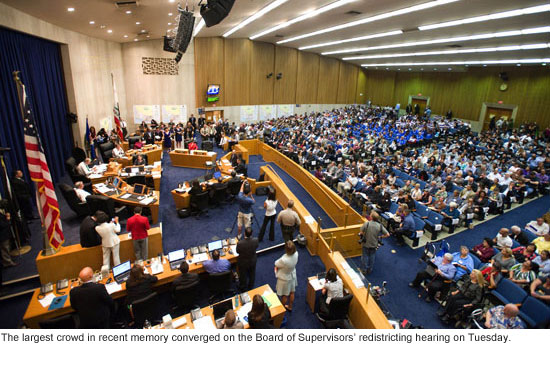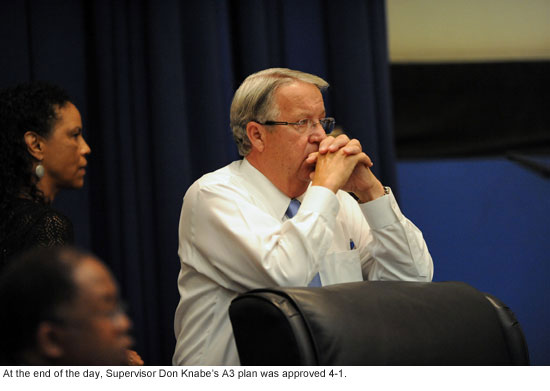The last map standing
September 28, 2011
 After weeks of robust debate that sparked thousands of letters, e-mails and public comments, Los Angeles County’s most contentious redistricting process in a generation came to a dramatic close Tuesday as supervisors voted 4-1 to approve new political boundaries that hew relatively closely to the current map.
After weeks of robust debate that sparked thousands of letters, e-mails and public comments, Los Angeles County’s most contentious redistricting process in a generation came to a dramatic close Tuesday as supervisors voted 4-1 to approve new political boundaries that hew relatively closely to the current map.
The supervisors voted after hearing six hours of public testimony from 243 speakers who invoked the history of Latinos in L.A., the meaning of changing demographics and sharply divergent opinions on whether “racially polarized voting” still exists in the county to such an extent that it denies Latinos an equal opportunity to elect a person of their choosing. Others asked supervisors to preserve existing “communities of interest” so that neighborhood priorities such as protecting the environment and building health care networks would not be jeopardized.
In approving the redistricting map known as A3, supervisors rejected competing proposals by Supervisors Gloria Molina and Mark Ridley-Thomas that had sought to create a second supervisorial district in which Latinos make up a majority of the citizen voting age population.
In an initial round of voting toward the end of Tuesday’s meeting, it became clear that none of the proposed maps would receive the 4-1 “supermajority” vote needed to pass. So, after a brief closed session and some minor amendments to the A3 plan offered by Supervisor Michael D. Antonovich, Ridley-Thomas signaled he would change his vote.
“There is a rather obvious lack of consensus on a map here today,” Ridley-Thomas said. With a possible legal challenge from the Mexican American Legal Defense and Educational Fund looming, he said he wanted to avoid a “potentially divisive delay” and to push the matter toward the “closure” of a federal court ruling on what the Voting Rights Act required.
While he said he still believed in the plans he and Molina had put forward, he said he wanted to avert “the unnecessary gamble of the uncertainty of an untested appeal process”—a reference to the special redistricting commission made up of the District Attorney, Assessor and Sheriff that would have stepped in to decide the matter if the five-member Board of Supervisors had been unable to muster four votes for any of the proposals. After Ridley-Thomas’ change of course, the board voted 4-1 in favor of the A3 plan, with Molina casting the dissenting vote.
Ridley-Thomas’ S2 map and Molina’s T1 proposal would have moved up to 3.5 million residents to new electoral homes and split the San Fernando Valley into three supervisorial districts instead of the current two. The plans drew strong reactions across the county, and were criticized as blatant gerrymandering by Supervisor Zev Yaroslavsky and others.
Knabe, in remarks before the vote, said that his A3 plan was the best way to ensure all groups in the county are well-represented. More radical boundary changes, he said, weren’t legally necessary and don’t reflect modern-day electoral realities.
“We cannot hold onto the past when we see clear illustrations of change with the election of minority candidates at every level of government,” Knabe said. “Hanging onto the legal battles of 20 years ago does nothing to move us forward…At the end of the day our job, as elected officials, is to represent all ethnicities, all people in Los Angeles County.”
Molina, however, in a presentation before the vote, contended that creating a second “meaningful Latino opportunity district” was required under the federal Voting Rights Act because of current demographics and a long history of bias.
“The legacy of Latino political exclusion and discrimination in L.A. County is so pervasive,” she said, “that it has affected not only the way Latinos and Latino candidates are perceived by non-Latinos but the way Latinos perceive their own ability to participate in the political process.”
Map A3, she said, waters down the voting strength of Latinos by creating a large Latino majority only in her 1st District while keeping their numbers to a third, or lower, in the other four districts. Latinos make up nearly 48% of the population countywide, and about a third of the county’s citizens of voting age.
Yaroslavsky kept his remarks brief, saying he had already written or said just about everything he needed to on the issue. But he thanked the community for what he called “this unprecedented turnout” and for the level of discourse throughout the process. “On the whole it was an elevated public testimony that we heard and it contributed to the public understanding … of what’s before us,” he said.
More than 900 people turned out for the meeting, arriving in the early morning, filling the board hearing room and spilling into three overflow rooms and a large white tent erected on the Hall of Administration lawn.
But by the time the final vote was taken just after 6 p.m., only a handful of spectators remained to witness the moment—the culmination of the once-every-decade process in which boundaries are redrawn to reflect U.S. Census data. (Click here for our story on the day-long civics lesson for hundreds of students who attended the meeting.)
The new district boundaries take effect in 30 days. Here are some of the changes in store forLos Angeles County under the plan:
More than 277,000 people will move to new districts, and several communities will get a new supervisor. Claremont, for instance, will move from the 5th District to the 1st. Santa Fe Springs will move from the 1st to the 4th.
Several other communities, now split between two supervisors, will be consolidated. The lake area of Silverlake will no longer be in the 3rd District, for instance; instead, the whole community will be drawn into the 1st District, as will all of Pico Rivera, Azusa and West Covina. Similarly, the 2nd District will encompass all of Hawthorne and all of Florence/Firestone, and the 4th District will include all of South Whittier and West Whittier/Nietos.
The San Fernando Valley will continue to make up more than 50% of the 3rd District’s electorate, and the 3rd District also will continue to represent the Westside, Hollywood and the Santa Monica Mountains. The 3rd District will lose 15,468 people, creating a district that is 45.8% white, 37.9% Latino, 11.1% Asian/Pacific Islander and 4% African American.
The population of voting-aged Latino citizens will fall in the 1st District from 63.3% of the electorate to 59.7%. In the 4th District, it will rise slightly from 31.6% of the electorate to 32.8%.
Asian Pacific Islanders, who had expressed concerns that redistricting would dilute their representation, will continue to be concentrated in the 1st, 4th and 5th Districts, with the highest concentration of voting-aged API citizens in the 1st District at 19%.
Population also will be more evenly distributed among the districts under the plan adopted Tuesday. Prior to A3’s approval, the largest district, the 5th, had 2,088,786 people, while the smallest, the 1st, had 1,893,001. That deviation, about 10%, will be reduced under the new plan to 1.57%.
Posted 9/27/11













 405 bridge work causes a stink
405 bridge work causes a stink
